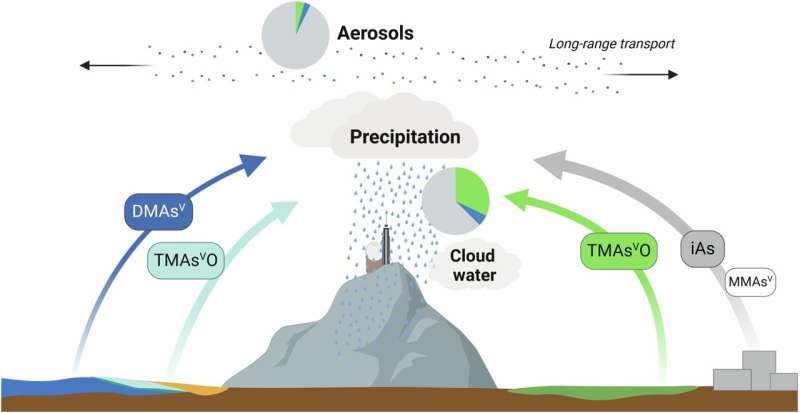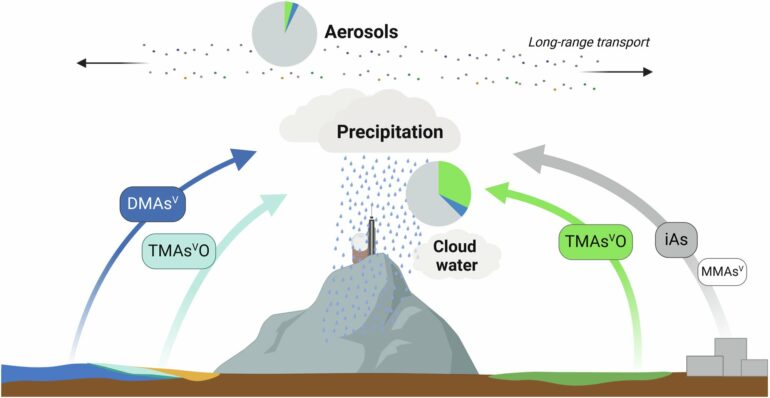On the Pic du Midi in the Pyrenees, ETH researchers have analyzed particulate matter, clouds and rainwater for traces of arsenic. Using newly developed measurement methods, they have elucidated the transport pathways of the environmental toxin in the atmosphere. The work is published in the journal Nature Communications.
Arsenic is a trace element that lies just below phosphorus—which is essential for all living organisms—in the periodic table. This close chemical relationship means that cells are not always able to tell the two elements apart. “The toxicity of arsenic is based on this risk of confusion,” says Lenny Winkel, Professor at the Institute of Biogeochemistry and Pollutant Dynamics at ETH Zurich, and the aquatic research institute Eawag.
Taking samples at 2,877 meters above sea level
For many years, Winkel and her team have been interested in this environmental toxin. It is estimated that about 31 kilotons orbit the Earth in the atmosphere. In order to find out more about the behavior and distribution of arsenic in the air, the researchers carried out an extensive measurement campaign at the Pic du Midi research station in the Pyrenees. The station is located at 2,877 meters above sea level and therefore enables measurements that are largely unaffected by local sources of pollution.
On the Pic du Midi, the researchers discovered, among other things, that clouds contain significantly more arsenic on average than rainwater. But anyone who is now worried about being poisoned by the next downpour can rest assured: “The arsenic is very diluted in the atmosphere,” says Winkel.
In fact, the researchers had to optimize their measurement method to be able to detect the arsenic at all. “The measurement limit is now 1 to 2 nanograms per liter, which is up to 20 times lower than the measurement limit of previous methods,” the researchers state.

Overview of source contributions for atmospheric arsenic (As) species in deposition samples collected at Pic du Midi Observatory. © Nature Communications (2024). DOI: 10.1038/s41467-024-53974-z
Characteristic transport patterns
A sophisticated model of air mass movements and chemical analyses of cloud and rainwater allowed the researchers to identify various characteristic transport patterns. And thus to find out for each sample where the arsenic came from. If a sample contained a lot of sodium, for example, the researchers concluded that the arsenic must have mixed with the salt stirred up in the sea (i.e., with sodium chloride) on its way to the Pyrenees.
However, Winkel’s team investigated dissolved organic carbon in other samples. “It can come from natural sources such as plants and pollen. But it can also be due to human-induced environmental pollution from transport or industry,” says Esther Breuninger, the first author of the scientific paper. She then adds, “In any case, the dissolved organic carbon indicates that the arsenic must have traveled over land masses before it ended up in our sample.”
Biological processes more important than expected
Winkel and her team detected several types of arsenic in the rainwater samples. In addition to the expected inorganic arsenic, they also found so-called methylated arsenic compounds. These compounds are formed when bacteria, algae, plants or fungi absorb inorganic arsenic and then excrete the poison in a converted form, thereby potentially protecting themselves. The researchers’ analyses show that the arsenic is converted both in the sea and on land.
“Until now, it was assumed that human activities such as the burning of coal or the smelting of ores were mainly responsible for atmospheric arsenic,” says Winkel. However, in some cloud samples, methylated compounds made up the majority of the arsenic detected. “These results show that biological processes play a more important role than previously assumed,” says Winkel.
Now, the influence of biological processes to the global arsenic cycle needs to be given more consideration in the models. “Apparently, living organisms contribute to the mobilization of historical arsenic pollution and its global distribution through their metabolism,” Winkel adds.
More information:
Esther S. Breuninger et al, Marine and terrestrial contributions to atmospheric deposition fluxes of methylated arsenic species, Nature Communications (2024). DOI: 10.1038/s41467-024-53974-z
Citation:
Arsenic’s atmospheric journey: New methods reveal environmental toxin’s transport pathways (2025, January 9)



